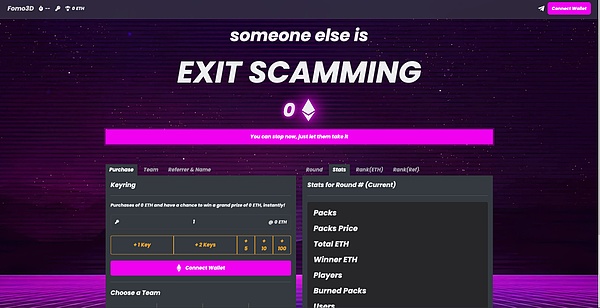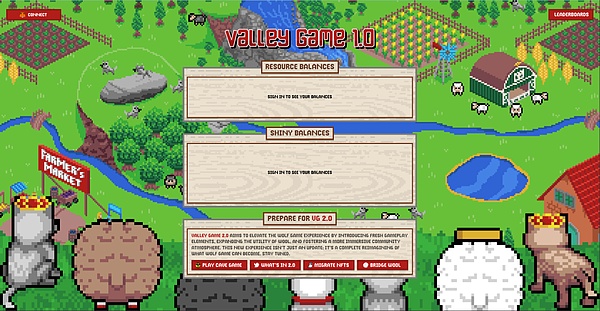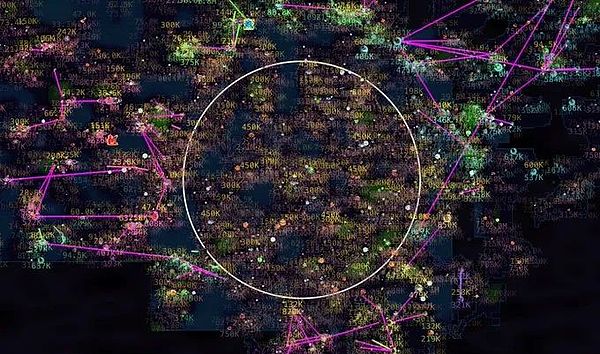1. Introduction: From Fomo3D to Rat Rooms, how do on-chain games break through the boundaries of games
In the crypto world, a type of game called Fully On-Chain Games (FOCG) is quietly building a new paradigm that is different from traditional games. From the Fomo3D that came out in 2018, to the Wolf Game that triggered a wave of blockchain farm craze, to the Dark Forest that introduced zero-knowledge proof to build the Dark Forest universe, to the new FOCG experiment that appeared in 2025, Rat Room leaf="">, these games together demonstrate a core feature of on-chain games:determined rules, random results, creating strategic space and gaming charm in the tension between certainty and uncertainty.
Compared to DeFi's financial logic and SocialFi's social network, this type of on-chain game is neither a "fun tool" nor a "money-making machine",but a native on-chain game form that deeply integrates gaming, assets and rules. What design philosophies behind this are unique to FOCG, indispensable, and directly drive its development forward?
Let's start with a few typical cases.
II. Typical FOCG Case Analysis
1. Fomo3D: Death Countdown and Prisoner's Dilemma
Fomo3D is one of Ethereum's early game experiments. It designed a seemingly simple mechanism: each purchase of a key will extend the countdown, and the last buyer will win the prize pool. However, the key is:The contract rules are completely transparent and cannot be tampered with, the countdown runs on the chain, and every change in Gas may disrupt the last second prediction.
Fomo3D's innovation lies in combining financial motivation (prize pool) with game psychology (grabbing the last knife) to construct a collective panic game, forming a mechanism of FOMO of "wanting others to take over but worrying about missing out".

Fomo3D official website: https://www.fomo3d.io/
2. Wolf Game: A composable farm of on-chain assets
Wolf Game introduces two types of assets, wolves and sheep, and combines the on-chain pledge income mechanism, stealing mechanism and inflation economic design to form an on-chain F
arming simulator of "value game + NFT holding rights". Players need to constantly make judgments between staking (earning Wool) and exiting (being stolen). The game promotes the idea of "gaming is finance" and "NFT is means of production" through minimalist mechanisms and on-chain execution, becoming a classic case of financial design in the blockchain game field.

Wolf Game official website: https://game.wolf.game/
3. Dark Forest: Exploration, collision and resource competition in the dark
Dark Forest uses zero-knowledge proof (zkSNARKs) to hide the game map. Players cannot know the full picture of the map in advance. They need to deploy spacecraft to detect, occupy planets, and calculate the profit path.
This is an on-chain game that introducesincomplete information game: the rules have been hard-coded through smart contracts, but the exploration path and opponent behavior are random and uncertain, making each game unpredictable, resulting in a high degree of strategic depth and player game tension.

Dark Forest official website: https://dfmud.xyz/
4. Rat Room: A 30-minute high-frequency financial gambling
Rat Room is a very novel FOCG experiment. It constructs a bilateral market with two roles: "room creators" and "rat players". Each room has an independent mechanism (asset entry and exit logic). Players place bets in different rooms and try to arbitrage to win the most tokens.
It emphasizes rapid trial and error and arbitrage strategies, replaces long-term growth with high-frequency gaming, and defines victory or defeat by "value increase or decrease" within 30 minutes.
Rat Room demonstrates a new idea: Game mechanics are contract logic, and player behavior is financial operation, and the sense of boundaries strongly reflects the game financialization philosophy of FOCG.

Rat Room official website: https://rat-room-pyrope.netlify.app/
III. FOCG's three unique underlying design philosophies
1. Determined rules + random results: a new narrative paradigm for on-chain games
FOCG The most representative underlying philosophy is:High certainty of rules + high uncertainty of results.
The certainty of the rules comes from the fact that the contract cannot be changed after deployment: every action, resource change, and time progress are driven by verifiable logic on the chain, without the intervention of the GM (Game Master), and no one can cheat.
But at the same time, uncertainty exists in large quantities in:
The game path of player behavior (the last 1 second of Fomo3D)
Incomplete information on opponent's actions (spaceship in Dark Forest)
Path dependence of dynamic asset configuration (the stealing system of Wolf Game)
text="">Arbitrage structure (Rat Room) constructed by room parameters
This tension structure creates a new narrative paradigm for on-chain games: it does not revolve around plot, characters, and upgrades, but aroundrules and human nature, probability and game. <span leaf="" para",{"tagName":"p","attributes":{},"namespaceURI":"http://www.w3.org/1999/xhtml"}]'>FOCG is like an "open maze", with clear rules but a chaotic ending, which is played out by everyone.
This is why many players experience unprecedented tension in these FOCGs:Everything is calculable but unpredictable.
2. Games are financial gaming fields: structural drive of incentive mechanisms
FOCG It is not a "game that can make money", it is the structuring of game behavior into financial behavior.
This structuring is reflected in three aspects:
Assetization : Almost all resources in the game can be transferred, combined, and sold (such as sheep NFT and Wool tokens in Wolf Game)
Financial incentive-driven :Players' behavior is not for the advancement of the plot, but for optimizing profit strategies, just like investors optimizing asset allocation
Mechanization of profit game:It is not motivated by designing a reward pool, but by letting the rules themselves produce "game motivation", such as stealing mechanisms and resource hedging
This design of the financial game field makes FOCG no longer a one-way "pass", but a continuous game and circular arbitrage, which is a native "strategy competition" model on the chain.
3. Composability and user autonomy: building a meta-game ecosystem
Compared to Web2 games that focus on IP, content and light on tools, FOCG tends to provide a minimum viable rule set (MVRG) and then let players co-create:
Wolf Game has spawned many imitations and module combination gameplay
Dark Forest encourages the co-creation of plug-ins, alliance systems and exploration algorithms
Rat Rooms itself has an open room construction mechanism, and users can customize the gaming field
This composability and player autonomy is one of the core differences between on-chain games and Web2:Instead of building a closed content universe, it creates a rule universe with "self-organizing potential".
Fourth, compared with traditional on-chain applications: Why these philosophies are necessary for the success of FOCG
Let's compare the above three unique design philosophies with other typical on-chain applications:
Underlying Philosophy | FOCG | DeFi | SocialFi |
|---|
Rules determined + results random | ✅ | ❌ | ❌ |
Games are financial games | ✅ | ✅ | ❌ |
Composability and User Autonomy |
| ✅ | ✅ |
DeFi emphasizes financial composability and deterministic execution, but lacks the combination of "strategy space + uncertainty".
SocialFi emphasizes user participation and incentive mechanisms, but usually lacks rule games and depth of gameplay.
Only FOCG can deeply integratecertainty and game theory, thus creating a closed experience loop that combines "non-linear narrative + strategic competition + financial motivation".
These unique philosophies are not icing on the cake, but the "foundation" that supports the establishment of FOCG.
V. Conclusion: Enlightenment of a New Paradigm
From Fomo3D to Dark Forest, from Wolf Game to Rat Room, the continuous evolution of these FOCGs shows that on-chain games are not just Web2 games moved to the chain, nor are they financial tools disguised for making money. They show another possibility:Using rules as text and players as variables, building a chaotic world in a deterministic contract.
The deep integration of rule certainty + result uncertainty, strategy games + financial incentives is the structural cornerstone of FOCG and a common element of current typical FOCGs.
How will FOCG develop in the future? Will it be empowered by AI to generate dynamic narratives and intelligent opponents, and build a truly "living game world"? Or will it be deeply integrated with on-chain social networking, with players not only competing for resources, but also for relationships and reputation? We don't know these yet. But what is certain is that the underlying design philosophies such as "determined rules, random results", "gaming is finance", and "system composability" have become the foundation for FOCG to be established and gradually break the Web2 game paradigm.
These philosophies not only shape the current FOCG's gameplay depth and user stickiness, but also provide direction for building a more complex, more lasting, and more autonomous on-chain game ecosystem in the future. No matter how technology evolves or how narratives change, as long as these philosophies continue and expand, FOCG will still have the opportunity to continue to lead a truly native gaming revolution in the Web3 world.
 Kikyo
Kikyo








